The Bangor S-Class Archive
Three S-Class boats under construction in the early 1960s

William Nixon’s S-Class Notes

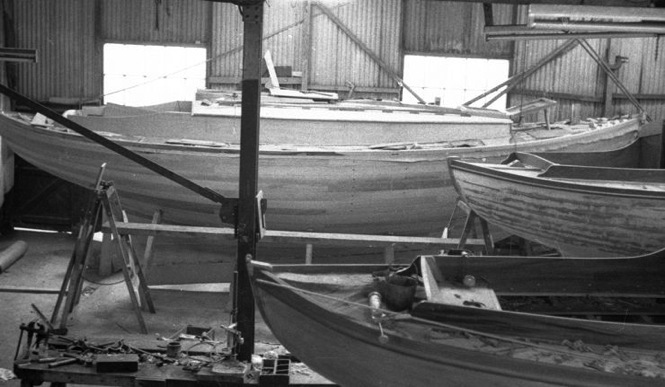
Bertie Slater - Robert N Slater AMRINA - was a Scottish boat-builder who settled in Ballyholme, the east bayside suburb of Bangor in County Down on the south shore of Belfast Lough, possibly some time in the early 1930s. In the inter-war years he developed the boatyard on the west side of Ballyholme Bay, a hundred yards or so south of the clubhouse of Ballyholme Yacht Club.
The yard was very busy with Admiralty work during World War II, but Bertie declined a government offer to cover the entire premises with two or three large sheds - he said he thought the money could be better spent elsewhere in the war effort. Most of the upper part of the yard was already a building shed, while the rest was open, with tracks and dollies for the moving of boats down to the single slipway, which was across the Seacliff Road and extended to low water springs on a curving rack through rock and sand.
As the northeast-facing bay was ironically described as “being snugly in the lee of Ailsa Craig”, choosing the ideal days for launching into its often unsettled and sometimes surf-torn waters was a delicate matter, as boats of any size had to be put gently down the slip at low water to await the incoming tide, providing a tense few hours as the tide made. However, Bertie Slater never misjudged it, but the fact that boats could be driven ashore from their moorings in Ballyholme Bay in onshore gales occasionally provided the yard with extra business for repairs - or funds for new boats to be built.

The Bangor shipyard before Bertie Slater - from a 1923 edition of The Yachting Monthly
He built a variety of craft, and in 1947 his Bangor Shipyard Company launched the first of a new cruiser class built to his own design, a 27ft cruiser-stern boat of hefty type with good accommodation and headroom, the S-Class. In the prototype, Stealaway for Ted Dunham, the orginal design for a markedly rounded stem profile was fortunately replaced by a cleaner gentler curve which provided a much better complement to the attractive canoe stern. However, one feature which Dunham required to be added later was a short bowsprit and cutter rig. This improved the helming characteristics and performance, but unfortunately - perhaps in the belief that bowsprits looked old-fashioned - it wasn’t retained in subsequent boats. And, for those who like a light but positive helm, the S-Class boats could seem a bit heavy to sail. In contrast Stealaway - she was very dark blue or perhaps even black when lying in solitary splendour on a mooring at Helen’s Bay - always seemed to have an extra edge in performance.
The hull profile was one of smooth soft curves, with only the slightest marked toe to the forward end of the underside of the long iron-ballasted keel. This meant that if engaging in “impactive pilotage”, sometimes the case in the Scottish cruising which was Bertie Slater’s inspiration, there would be minimal damage, but it did mean that the S-Class lacked a certain bite in going to windward.
The accommodation was outstanding for its era, indeed it still seems remarkably good. Starting from aft, the auxiliary under the companionway shows a proper Scottish regard for engineering best practice - it is virtually horizontal, a requirement occasionally ignored by some designers and builders, who feel they can get away with engine angles which disregard the manufacturers’ basic requirements. The only modification which springs to mind is that the propeller aperture could be taken almost entirely out of the hull deadwood - if the rudder could be given a straight leading edge, it would greatly improve manoeuvrability under engine when going ahead.
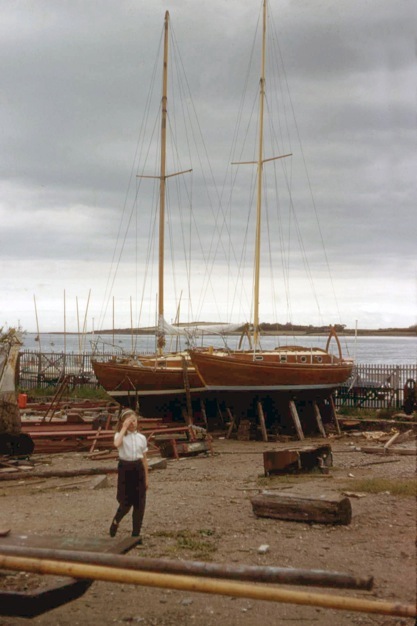
It’s all as neat as can be, and works a treat - my late older brother, while a young teenager, went on a fortnight’s cruise to Scotland with the Slater family on their own S-Class boat Seaquester (finished 1949) and the thing he most vividly recalled was that Mrs Slater insisted they anchor for lunch in the middle of each day’s passage, something which is theoretically possible in many parts of Scotland, but most people didn’t do it in those days as anchoring was such a hassle. On the S-Class, it was one of the easiest things of all, and when Seaquester was at home in Ballyholme Bay, you became accustomed at weekends to see her temporarily yet conveniently anchored in all sorts of little coves around Belfast Lough, places where other boats wouldn’t think of staying.
As we lived in a beachside house at the eastern end of Ballyholme Bay, as kids we were often in and about the boatyard making nuisances of ourselves, so between 1946 and 1964 I would have seen most of the S-Class under construction by the yard’s ace craftsman Scotty, who apparently had been trained as a mechanic, not a shipwright, but he did lovely work.
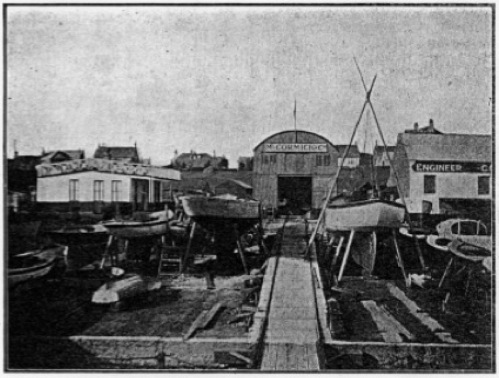
Two S-Class boats in for maintenance
My Father owned one of the Glen Class sloops, 25ft Mylne-designed boats which raced at Bangor as the Royal Ulster YC No 1 Class. As this family boat (built at the west side of Bangor in 1948 at the Glen Boatyard) was “only a day sailor”, anything with the slightest whiff of real cruising about it seemed exotic, and the S-Class boats spoke of other places beyond the seas. Bertie Slater may have hoped he could convert my Father (who was the Local GP) to cruising, so one day he had his son Ronnie take Seaquester with all the Nixons aboard on a day cruise to the heart of Belfast.
It was a breezy morning with rain on the way, but we got to a lunchtime berth in the heart of the city, then in rain and no wind motored the whole way home again. This left the kids exhausted, but I remember being hugely impressed by my Father who - having seen us all home and after grabbing a quick cup of tea - then returned to the Glen to race her on that miserable evening in the final race of a local evening series. They duly won, so any notions of ordering a new S-Class boat went on the back burner and stayed there.
However, many others were ordered, and for a while my younger brother James owned one - Spelga - which he kept in Strangford Lough. He bought her from Dennis MacNeice. I see she is now based at Troon on Lough Fyne. Boat number nine - Sarcelle - was built for Fergus McKinley of Dublin Bay, who used to come north and stay in Ballyholme from time to time to watch his new boat being built. He met a local girl and married her, and stayed married to Sarcelle too for very many years, mooring her off his club, the Royal Irish YC in Dun Laoghaire.
The S-Class cabin - Stealaway, the first boat, shows how it should be done
Segala was owned by John Osborne of Mulroy Bay in Donegal, where she lay on moorings off his house for many years. There was another S-Class boat which was based in the Sligo area, and one which was in the Shannon Estuary, owned (I think) by Larry Swann, and another owner was Wally Fogarty (although these may have been two different boats). Nearer home at Ballyholme, a long time S-Class owner was Norman Reid with Southward. She was dark blue, and he cruised her regularly to the West Coast of Scotland. His family - like many in Bangor - traditionally decamped to Donegal for the school summer holidays, and as Norman was unable to take the entire summer off from work in Belfast, he would sail Southward round to the sheltered anchorage of Ringhaddy in Strangford Lough and live aboard, commuting by car to Belfast.
Sorona was one of the first of the masthead-rigged boats. Her first owner was Teddy Maxwell, whose previous boat, the “cruiserfied” 31ft Belfast Lough Star Class Corona of 1902 vintage, had been wrecked from her moorings in Ballyholme in a nor’easter, hence the funds for the new boat, and the name.
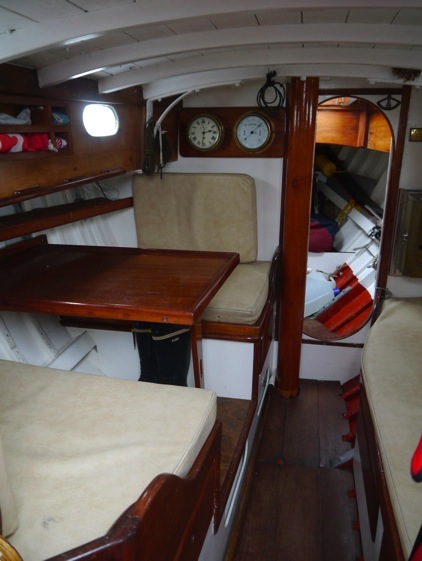
Seaquester gets a starring role in an advertisement for October Gloss varnish
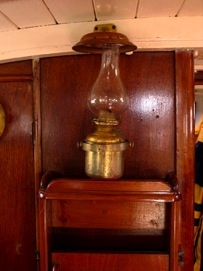
We see visiting S-Class boats here in Howth from time to time, and there may even be one or two based on the other side of Dublin Bay in Dun Laoghaire’s huge harbour and vast marina. Then too I sometimes meet up with them while cruising. It’s a bit thought-provoking to see boats which I witnessed being built now looked on as vintage classics; but that said, I can clearly remember our brand new Glen OD being launched in 1948, and these days the Glen Class in Dublin Bay and Strangford Lough promote themselves as vintage yachts providing an historic sailing experience.
There is now virtually no trace of the Glen Boatyard on Smeltmill Bay in West Bangor, but while the Bangor Shipyard Company has long since become residential development, there is still the long slipway down which every S-Class boat was gently trundled for her first launch, winding its way in a gentle slope between rocks to the sandy sea.
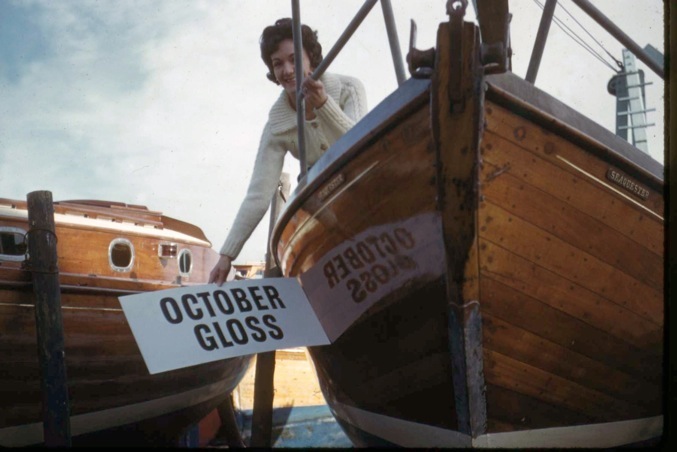
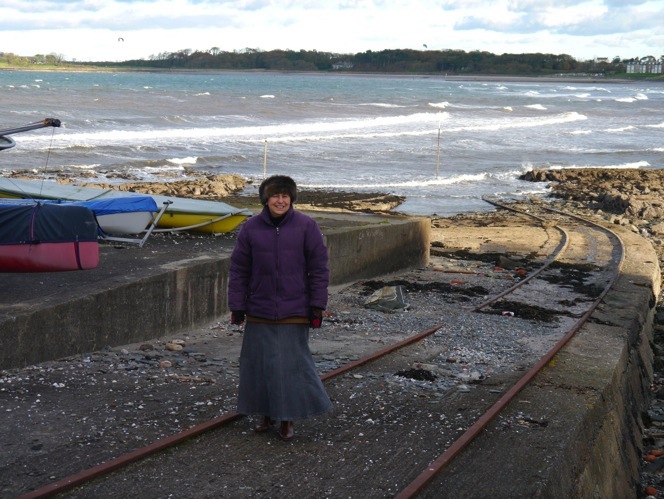
Ann Pearsons - co-owner of Stealaway - on the Bangor Shipyard Company slipway in 2012
